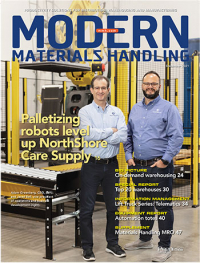Palletizing Robots Bring New Level of Efficiency to North Shore Care Supply
The distributor of incontinence products was already using autonomous mobile robots in its picking operations. Now, robotic palletizing is speeding up receiving, taking labor out of the process and creating a safer work environment.
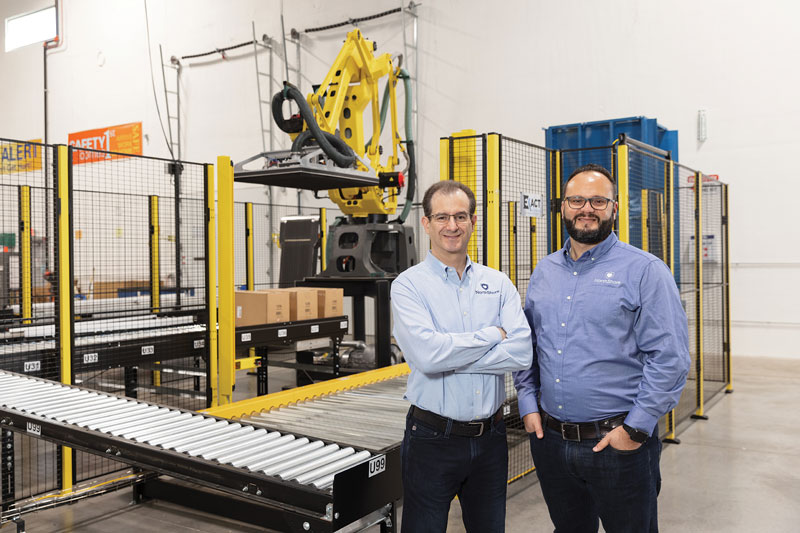
Editor’s note: This is the second of two stories focused on the adoption of automation by small to mid-sized distributors. In the November issue, we learned how Top Notch Distributors made the leap from paper-based, pick-to-cart operations to system-directed pick-to-robots. In this issue, we revisit NorthShore Care Supply, which we featured in the September 2020 System Report, to see how and why this distributor of incontinence products is using a palletizing robot to speed up its receiving operations.
In July of 2020, early into the pandemic, I had a chance to tour a recently opened 173,000-square-foot distribution center north of Chicago operated by NorthShore Care Supply. The company was founded by Adam Greenberg in 2002, a University of Chicago MBA grad who was looking for a startup idea. He got the idea for what is now one of the leading suppliers of products for incontinence after some family members who were going through illnesses expressed their reluctance to purchase products like Depends at the grocery or drug store.
The idea of purchasing online for reasons of privacy and the convenience of home delivery seemed natural. Once he turned on the website, he learned of his customers’ frustrations with the performance of many of the products available in the stores and turned his focus to higher quality products, a customer service staff able to answer embarrassing questions, and fast and easy delivery. A business was born.
Take a closer look inside the NorthShore Care Supply operation here.
After operating for more than a decade from several smaller facilities, including an 86,000-square-foot DC about 10 miles from the new facility in Green Oaks, Ill., the new distribution center doubled the square footage and provided room to grow for a company that was then experiencing 30% year-over-year annual growth.
But the new facility—the company’s fifth since its founding—featured more than additional space. It contained a high level of automation for a small to mid-sized company. The centerpiece was a robot-to-goods picking system designed by Numina Group that used autonomous mobile robots (AMRs) from Waypoint Robotics, recently purchased by Locus Robotics. A unique feature was the robots’ capacity to carry much heavier loads than a typical AMRs, up to 700 pounds. This was essential since NorthShore Care ships full cases of product to its customers. Those cases were delivered to a fairly automated packing, labeling and shipping line.
At the time, Greenberg, the company president, told me he embraced automation for several reasons: First, it was now affordable and in the reach of mid-market companies like NorthShore Care Supply. Second, automation allowed him to build capacity into the system—he saw a 40% to 50% improvement in the speed of picking along with improvement in accuracy. And finally, automation allowed him to do more with less.
“This is not an area with a large blue-collar labor force,” Greenberg says, adding that with Amazon, Uline and Medline operating large DCs nearby, they were competing for available warehouse labor. “We were struggling to find people looking for a permanent job, and temps wanted to jump from warehouse to warehouse,” he says. “That was a challenge for the five years before Covid.”
Fast forward to July 2021, when I toured the Green Oaks facility once again. The AMRs were still traveling through the aisles, associates were busy picking to the robots and moving product through the packing stations, and lift truck operators were moving pallets to replenish pick locations.
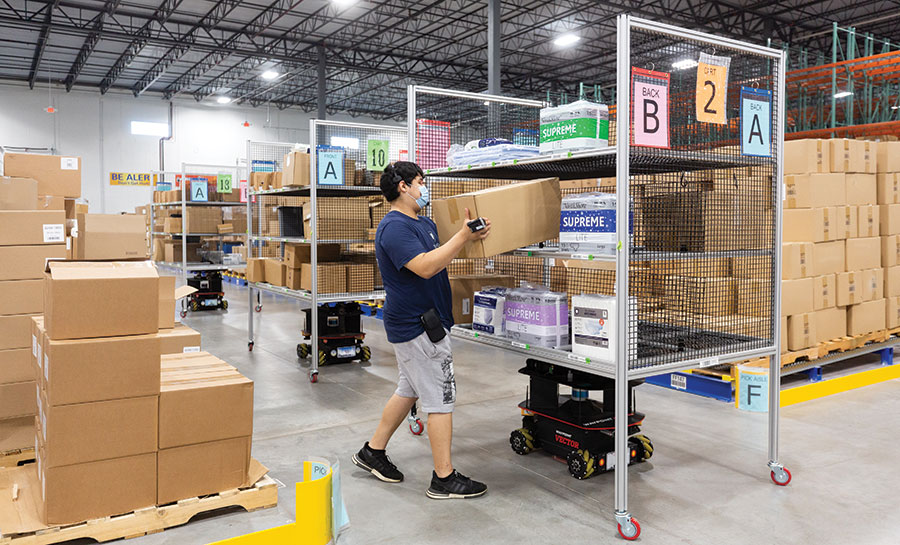
Autonomous mobile robots (top) are used for order fulfillment processes.
I saw two big differences: Significantly more inventory was in the warehouse than in July 2020, and, at the receiving dock, two associates were unloading cartons onto a powered conveyor from inside a shipping container. Those cartons were then directed to a robotic palletizing cell designed by a system integrator (Exact Automation). There, empty pallets were automatically dispensed from a pallet dispenser; cartons queued in one of two staging lanes; and a Fanuc robot picked them up two at a time to build one of 20 distinct palletizing patterns.
Like the AMRs in picking, robotic palletizing was bringing a whole new level of efficiency to the receiving operation at a time when it is desperately needed. More on that in a moment. “It was taking us 8 manhours per container to unload and most of that was on overtime,” Greenberg says. “We’ve only had the palletizing cell operational for a few months and we’re at 3 manhours for about 80% of the containers we unload. With further optimization, we think we can get that down to 2.5 hours per container.”
An added benefit: The reduction in labor associated with receiving also reduces the potential for repetitive stress injuries from repeated lifting, creating a safer work environment.
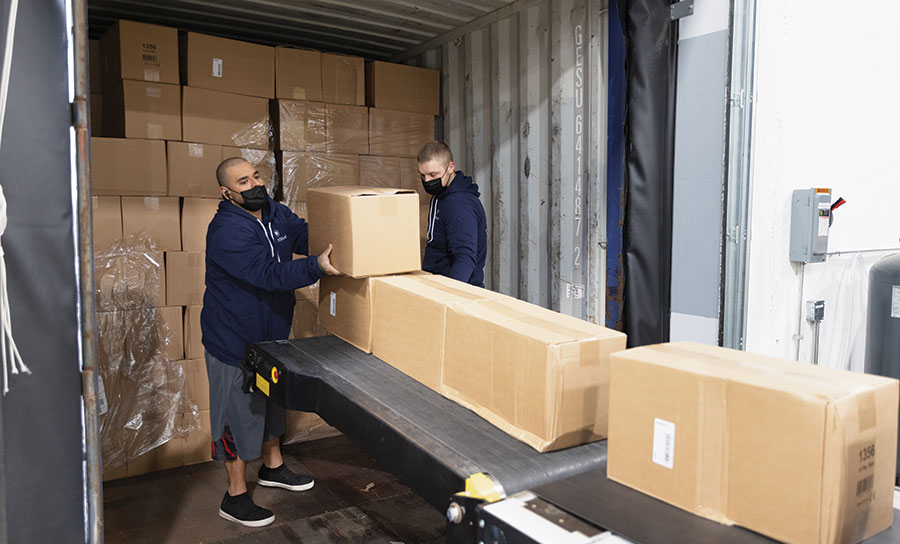
In receiving, associates unload cartons onto an extendable conveyor.
The difference a year makes
Like last month’s cover story on Top Notch Distributors, NorthShore Care Supply goes deep in a niche Industry. In this instance, it’s an extensive catalog of incontinence products along with personal products essential for daily living.
What the two companies share with many small to mid-sized distributors of specialty products is that they have to compete head-to-head on price and customer service with retail and e-tail giants, including Amazon.
They often distinguish themselves on selection and customer service. That includes knowledgeable customer service representatives who are experts in the product lines to help a new customer select a product that will improve their lives, along with consistent, reliable and superior order fulfillment and delivery. People need these products when they need them.

Cartons are conveyed to the palletizing cell.
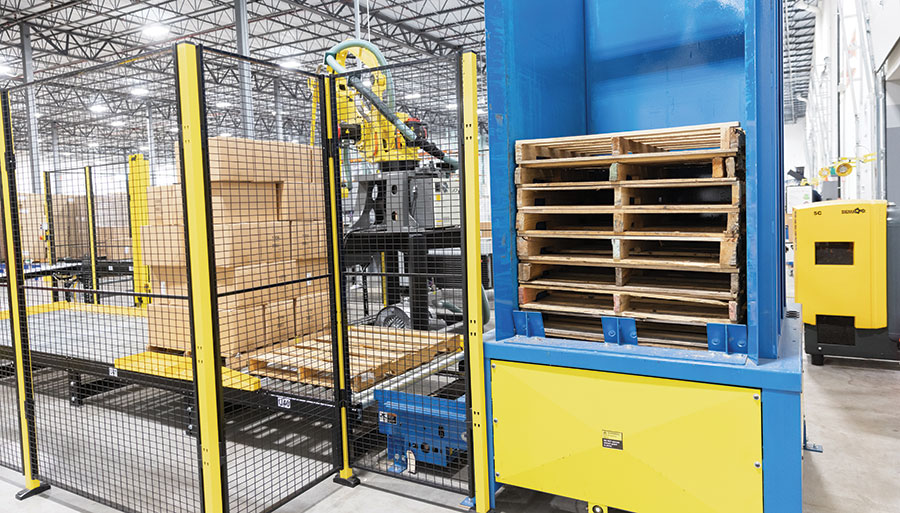
Pallets are automatically dispensed.
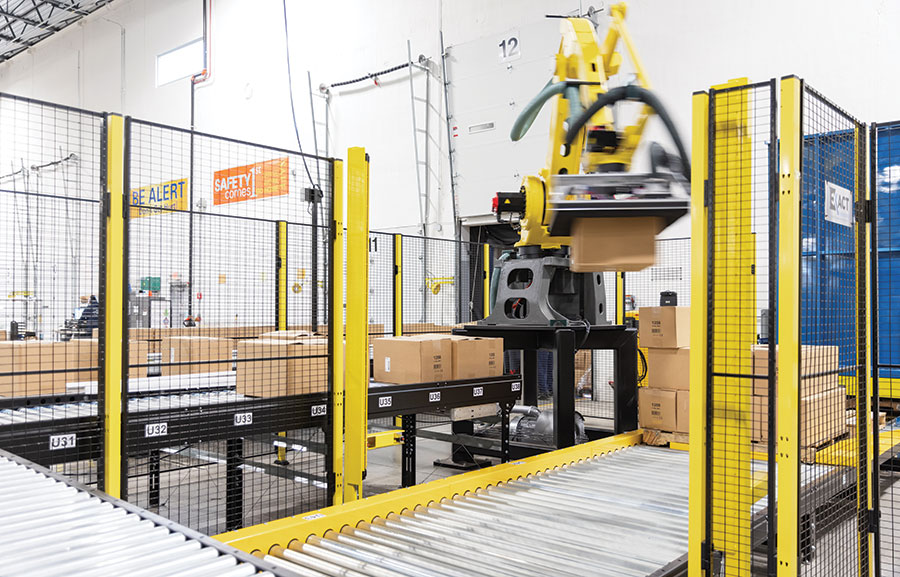
The robot picks up cartons from the conveyor.
As the price of computing power and electronic components has come down, emerging automation technologies are putting powerful new tools in the hands of small companies and enable them to compete on service and keep pricing structures in check. After all, people will only pay so much, even for superior products. As Greenberg told us last year, automation is a competitive advantage, and to get the most for it, he looks for cutting-edge providers that may be looking for a beta site to put their technology to the test.
In the year since my visit to NorthShore Care Supply, the business has continued to grow and evolve. Meanwhile, Greenberg is experiencing the same labor shortages and supply chain disruptions as most other manufacturers and distributors, regardless of size. So, what’s happened?
For one, the privately held company has continued on its growth path, driven in part by the “general boom in e-commerce in all categories,” says Greenberg. “Before Covid, the biggest share of our marketing was to get people out of the stores and into the routine of buying online. Now, if they do go into a store, not everything is on the shelf, and in this category, a necessary specialty item, buying online is more reliable.”
Secondly, private label NorthShore branded products are becoming more of a focal point of the business. “It’s grown from 80% of the business a year ago to more than 90% today and will be more than 95% of our business by the end of this year,” Greenberg says.
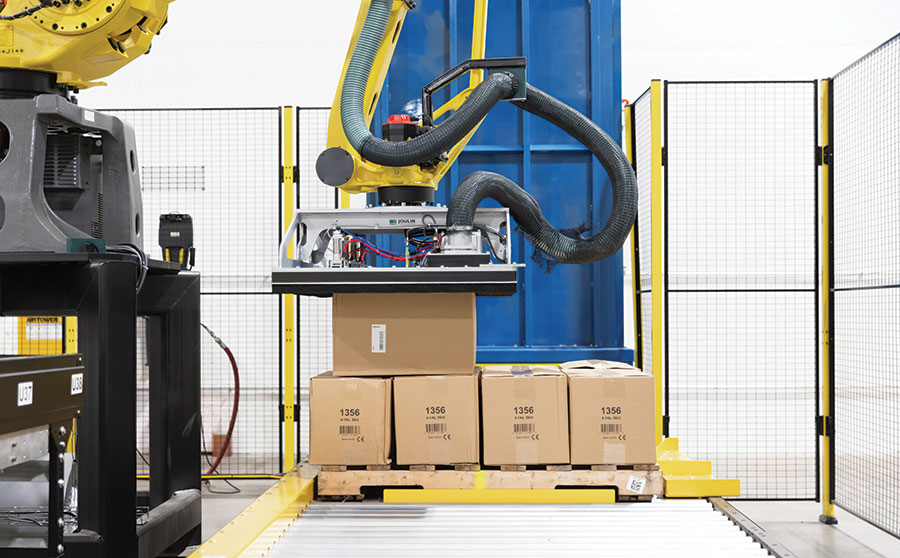
The robot builds the pallet from a number of stored palletizing pallets, according to the SKU.
The increase in private label product increases NorthShore’s reliance on manufacturers in the United States, Europe and China, and now shipments back to customers in Europe. As a result, the company is experiencing shutdowns, shortages and unpredictable shipping.
“Our overseas suppliers are backlogged and our domestic suppliers are shut down,” he says. “Lead times from Asia have grown from 5 weeks to 15 to 20 weeks, and we have to add an extra 4 to 6 weeks from Europe. And, we’re paying extra.”
Meanwhile, NorthShore Care’s customers rely on its products, so the company is ordering “just in case inventory, and then we add some,” says Greenberg, explaining the reason for the extra inventory in the facility compared to a year ago. The result is that “our receiving operation is experiencing twice the growth rate of our outbound operation,” he adds.
Meanwhile, containers arrive when they arrive—some weeks he gets 10 to 15 that have to been unloaded and turned around promptly to avoid demurrage fees and some weeks the facility gets none. Layer on top of that a worsening labor situation, and the facility was ripe for an expansion of automation into receiving.
Bringing in more robots
The unpredictability of shipments means Greenberg couldn’t really bring on full-time staff that may only be needed on occasion. Temp labor was scatter-shot at best.
“One day, we had 12 temps lined up to unload containers,” Greenberg says. “Only five showed up and only one stayed for the whole shift. It’s hard, manual labor, and other very large DCs in our area are paying big bonuses to attract help.” He tried to rely on overtime, but eventually continual overtime burns out the existing workforce. “They’re worn down from manually unloading trailers, and it’s hard to replace them,” Greenberg says. “It became an absolute necessity to automate that part of the operation.”
NorthShore Care investigated robotic palletizing during the initial design of the distribution center, but it was more than they thought they could handle at one time. “We decided to wait until we were at an optimized state with the other projects,” Greenberg says. That time was now.
Research for the project began in the fall of 2020. Along with discussions with existing vendors, an important resource was the website for PackExpo’s 2020 virtual event. NorthShore Care sent out RFPs to six potential vendors, received proposals from four, including three that provided detailed plans.
“We ended up adjusting the layout a number of times to shrink the overall footprint of the solution,” Greenberg recalls. “Initially, we thought we wanted more conveyor and space than we installed to handle more product and more SKUs at the same time. In the end, we decided that warehouse space could be a factor in the future, and to focus on one SKU at a time coming out of the containers. That way, we didn’t need a lot of room for queuing and staging.”
Those changes also allowed Greenberg to keep the cost of the project under $500,000. The projected ROI was two years, with a goal of getting unloading and palletizing down to two manhours per container and to do it all without overtime. Exact Automation was selected for the integration for several reasons:
- Proximity: They were located less than an hour away from NorthShore Care’s facility.
- Expertise: Robotic palletizing was a focus for the integrator.
- Availability: They were able to commit to doing the project right away, and, with their vendor connections, were able to source the equipment and components needed to complete the project in a timely manner.
The contract was signed in March and the robotic cell was fully operational by the middle of July 2021.
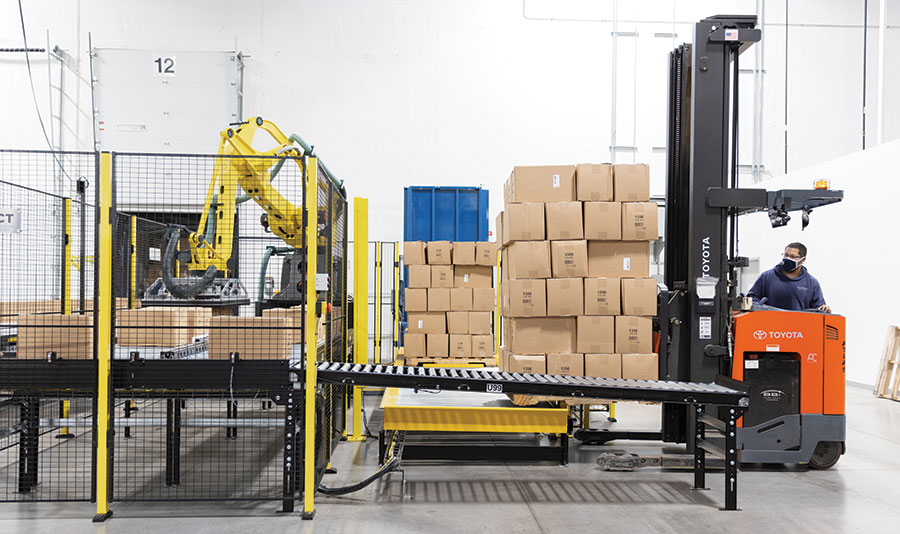
Completed pallets are staged and then picked up for putaway by a lift truck operator.
Palletizing
The project was able to take advantage of reinforced concrete that had been poured when the facility was built, and a mobile, extendable powered conveyor that NorthShore Care had purchased for the original go-live.
“We knew when we moved into the building that everything we could do ahead of time to make manual labor more efficient would be worth it,” Greenberg says. The conveyor was mounted on rails so it could slide between two receiving docks. “We can only unload one trailer at a time because we only have one extendable conveyor,” he says.
The operation is relatively simple. Two associates are assigned to a container, and most containers have one or two SKUs each. One of the associates scans a carton so the palletizer knows what to expect, and then the pair unload cartons onto the powered conveyor.
Cartons are directed to one of two staging lanes. Once cartons are staged, the robot picks them two at a time to build a pallet according to stored patterns. Once a pallet is complete, it’s ejected to a pickup location where a lift truck operator will get it and take it to storage, or use it to replenish a picking location. As noted earlier, NorthShore is realizing a nearly 60% reduction in the time required to unload a trailer, plus the elimination of overtime in the receiving process.
Modifications include a bypass module for SKUs that are slow movers or infrequently received: It made more sense to palletize those by hand rather than create a pre-loaded stacking pattern. “When the unloaders scan a bar code in the trailer, they skip the two pick lanes and are ejected to a manual palletizing lane,” notes Jared Bell, who recently joined the company as the vice president of operations and business development.
NorthShore is not done automating. Warehouse manager Yutaka Takaki notes that future projects may include automatic lift trucks or pallet-handling AMRs for non-value-added travel, such as from receiving to a drop zone for putaway. “As we’re moving more and more pallets, that could make sense, he says, adding that they have also done preliminary work to bring more automation to packing. “The timing isn’t right, but we continue to talk to vendors,” he says.
Greenberg believes that continued automation is critical to NorthShore Care’s success. “Getting orders out is so critical to us,” he says. “Automation makes it easier for us to be in control of our own destiny. If you can afford to make the right investments, you can deliver the customer experience you need to be successful.”

Article Topics
Palletizing News & Resources
Liberty Reach rebrands to Liberty Robotics Inc. GXO pilots AI-enhanced robotics in warehouse The value of automated palletizer, depalletizer collaboration A central nervous system for right-sized packaging Cobot as key ingredient for palletizing efficiency Efficient Deep Storage for Palletized Loads Mujin secures $85 million in Series C funding More PalletizingLatest in Materials Handling
IFR: robot installations by U.S. manufacturing companies up 12 percent last year Geek+ and System Teknik deploy PopPick solution for pharmacy group Med24.dk Beckhoff USA opens new office in Austin, Texas Manhattan Associates selects TeamViewer as partner for warehouse vision picking ASME Foundation wins grant for technical workforce development The (Not So) Secret Weapons: How Key Cabinets and Asset Management Lockers Are Changing Supply Chain Operations MODEX C-Suite Interview with Harold Vanasse: The perfect blend of automation and sustainability More Materials HandlingAbout the Author
Subscribe to Materials Handling Magazine

Find out what the world's most innovative companies are doing to improve productivity in their plants and distribution centers.
Start your FREE subscription today.
April 2024 Modern Materials Handling

Latest Resources


